
Merseyrail is a commuter rail network which serves Merseyside and adjacent areas of Cheshire and Lancashire. Merseyrail serves 69 stations, 67 of which it manages, across two lines – the Northern Line and the Wirral Line. The network uses 750 V DC third rail electrified lines having 75.0 miles (120.7 km) of routes, of which 6.5 miles (10.5 km) are underground. Since January 2023, Merseyrail commenced replacing its train fleet, withdrawing the Class 507 and 508 trains and introducing 53 new Class 777 trains. The network carried 25.5 million passengers in the 2022/2023 statistical period.
Merseytravel is the passenger transport executive, responsible for the coordination of public transport in the Liverpool City Region in North West England. Merseytravel was established on 1 December 1969 as the Merseyside Passenger Transport Executive. From 1 April 2014, with the creation of the Liverpool City Region, Merseytravel expanded its area of operation from the metropolitan county of Merseyside to also include the Borough of Halton.
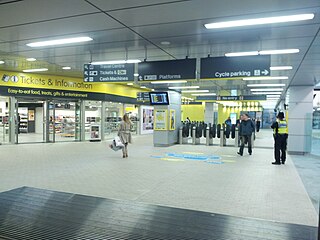
Liverpool Central railway station in Liverpool, England, forms a central hub of the Merseyrail network, being on both the Northern Line and the Wirral Line. The station is located underground on two levels, below the site of a former mainline terminus. It is the busiest station in Liverpool, though considerably smaller than Lime Street station, the mainline terminus, and the busiest station to operate solely on the Merseyrail network. The station is the busiest underground station outside London serving 40,000 people daily. The station in passengers per platform is the busiest underground railway station in the United Kingdom at 5,217,547 per platform per annum and laying third in all stations, underground or overground.

The British Rail Class 507 is a type of electric multiple unit (EMU) passenger train built by British Rail Engineering Limited at Holgate Road carriage works in two batches from 1978 to 1980. They are a variant of British Rail's standard 1972 design for suburban EMUs derived from PEP stock, which eventually encompassed 755 vehicles over five classes. They have worked on the Merseyrail network from new and continue to do so, having been refurbished by Alstom's Eastleigh Works.

The British Rail Class 508 (4PER) was a type of electric multiple unit (EMU) passenger train built by British Rail Engineering Limited, at Holgate Road carriage works, York, in 1979 and 1980. They were a variant of British Rail's standard 1972 design for suburban EMUs, eventually encompassing 755 vehicles and five classes (313/314/315/507/508). They mostly worked on the Merseyrail network from 1982 until withdrawal on 16 January 2024.

Ormskirk railway station in Ormskirk, Lancashire, England, is a cross-platform interchange between Merseyrail services from Liverpool Central and Northern Trains services from Preston on the Ormskirk branch line, 12+3⁄4 miles (20.5 km) northeast of Liverpool. The station building and three arch road bridge are both Grade II listed structures.
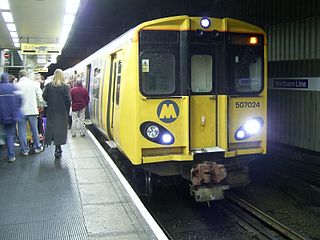
The Northern line is one of two commuter rail routes operated by Merseyrail and centred on Merseyside, England, the other being the Wirral line. The cross-city route runs from Hunts Cross in south Liverpool then branches in the north to terminate at Southport, Headbolt Lane and Ormskirk (Lancashire).

The Wirral line is one of two commuter rail routes operated by Merseyrail and centred on Merseyside, England, the other being the Northern line.
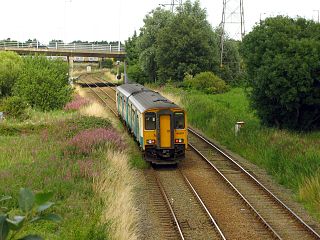
The Borderlands line, also known as the Bidston–Wrexham or Wrexham–Bidston line, is a railway line between Bidston on the Wirral Peninsula in England and Wrexham Central in the north-east of Wales. Passenger train services are part of the Wales & Borders franchise and are operated by Transport for Wales Rail. The line connects to the Merseyrail network at Bidston, the North Wales Coast Line at Shotton and the Shrewsbury–Chester line at Wrexham General. Parts of the line in Wales are used by freight trains, serving Deeside Industrial Park and the Hanson Cement works to the south of Buckley.
The Skelmersdale branch was a standard gauge railway (SKE) which connected the Liverpool, Ormskirk and Preston Railway at Ormskirk with Rainford Junction via Skelmersdale. At Rainford it connected with the Liverpool and Bury Railway and the St. Helens Railway. It was built by the East Lancashire Railway, which was taken over by the Lancashire and Yorkshire Railway shortly afterward. The steam railmotor which served the line was sometimes known locally as the "Skem Dodger" and other times as the "Skem Jazzer".

Kirkby railway station is situated in Kirkby, Merseyside, England. It is situated 7.5 miles (12 km) north-east of Liverpool Central and is on the Kirkby branch of Merseyrail's Northern Line.

Stadler Rail is a Swiss manufacturer of railway rolling stock, with an original emphasis on regional train multiple units and trams, but moving also into underground, high speed, intercity and sleeper trains. It is also producing niche products, such as being one of the last European manufacturers of rack railway rolling stock. Stadler Rail is headquartered at its place of origin in Bussnang, Switzerland. Stadler Rail employed 13,400 employees by 2022.

Birkenhead North TMD is a traction maintenance depot, which is owned by Network Rail and operated by Stadler. Located opposite Birkenhead North railway station, it is currently responsible for servicing and stabling Merseyrail's fleet of Class 507, 508 and class 777 electric multiple units.
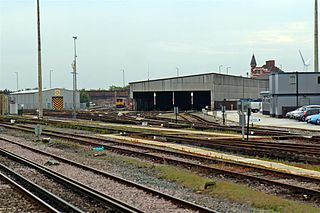
Kirkdale TMD is a traction maintenance depot located beside Kirkdale railway station in north Liverpool, England. The depot is the largest on the Merseyrail network; it is located on the Northern Line and is used primarily for stabling units, heavy maintenance and cleaning units both internally and externally. It is owned by Network Rail and operated by Stadler.

Skelmersdale railway station was a station located on the Skelmersdale branch at Skelmersdale, England. The station was originally named Blague Gate, having its name changed to Skelmersdale on 8 August 1874 and carried passengers from 1858 to 1956.

The City Line is the brand name used by Merseytravel on suburban rail services in the Liverpool City Region starting eastwards from the mainline platforms of Liverpool Lime Street railway station.
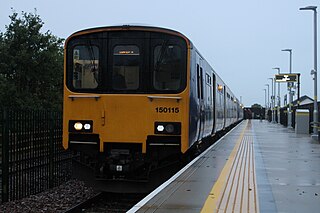
The Kirkby Branch Line is a branch railway line from Wigan to Headbolt Lane. The line's original route was from Liverpool to Bury and later the most northern of the Liverpool to Manchester lines. The line was split at Kirkby in 1977 with the western section forming a high frequency branch of the electrified Merseyrail Northern Line, also referred to as the Kirkby branch line. The Kirkby branch to Wigan remained a low frequency diesel operated service by Northern Trains from Headbolt Lane to Manchester.

Headbolt Lane is a railway station in Kirkby, Merseyside, England, which opened on 5 October 2023.

A battery electric multiple unit (BEMU), battery electric railcar or accumulator railcar is an electrically driven multiple unit or railcar whose energy is derived from rechargeable batteries driving the traction motors.

The British Rail Class 379 Electrostar is an electric multiple unit (EMU) passenger train which was designed and built by Bombardier Transportation. The trains are part of the company's extensive Electrostar family.






















